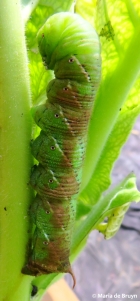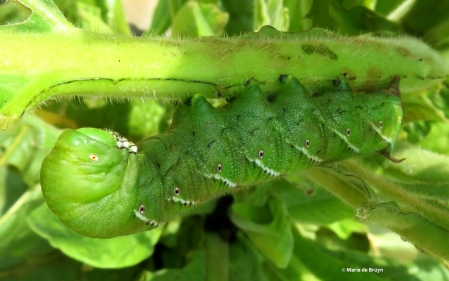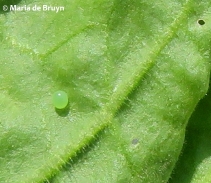Some of the large moths, like the polyphemus (Antheraea polyphemus) and cecropia (Hyalophora cecropia, below) moths, definitely rival butterflies in their beauty and splendor. Before launching into a series on some Central American wildlife, I thought I’d share a couple recent moth-related spottings that I had.
The luna moth (Actias luna) is a large lepidopteran that entrances people and I recently saw one along a path in the Mason Farm Biological Reserve. Unfortunately, the insect had died but the cause was not apparent. Perhaps it was a parasitic fly that was originally introduced to help control invasive gypsy moths or perhaps it had simply reached the end of its life span.
This past year, I was fortunate enough to see the cocoons of both the polyphemus (left) and cecropia moths but I had not seen the large caterpillars associated with some large moths.
 Then, just a few days before departing for a trip to Costa Rica, it was my good fortune to visit a garden that had two species of large hornworms. The tobacco hornworm is the immature form of the Carolina sphinx moth (also known as the tobacco hawkmoth; Manduca sexta). The tomato hornworm, the caterpillar of the brown and gray five-spotted hawkmoth (Manduca quinquemaculata) looks very similar except that it has a black or dark blue horn instead of the orange one sported by the tobacco hornworm.
Then, just a few days before departing for a trip to Costa Rica, it was my good fortune to visit a garden that had two species of large hornworms. The tobacco hornworm is the immature form of the Carolina sphinx moth (also known as the tobacco hawkmoth; Manduca sexta). The tomato hornworm, the caterpillar of the brown and gray five-spotted hawkmoth (Manduca quinquemaculata) looks very similar except that it has a black or dark blue horn instead of the orange one sported by the tobacco hornworm.
The tomato hornworm is distinguished by v-shaped marks (right) while the tobacco hornworm has beautiful black-bordered straight white lines on its body. I find both species attractive but particularly like the tobacco hornworm caterpillars.
They are so cute with their rounded heads and little suction-cup-like feet.
Both species of caterpillar can be found on either tomato or tobacco plants as they consume the foliage of various plants in the nightshade family. The presence of frass (insect larvae poop) alerts you to which plants may be hosting the hornworms.
 These moth species originated in Central America and are now considered by some people to be garden pests, especially when they eat tomatoes. It seems that planting marigolds next to the fruit can repel the caterpillars, who eventually pupate and then overwinter underground where they have fallen off plants.
These moth species originated in Central America and are now considered by some people to be garden pests, especially when they eat tomatoes. It seems that planting marigolds next to the fruit can repel the caterpillars, who eventually pupate and then overwinter underground where they have fallen off plants.
There are parasitic wasps that also prey on the hornworms. One species attacks the tiny hornworm eggs, which are laid on leaves; another wasp lays its eggs in the body of the caterpillars.
The Kingsolver Lab at the University of North Carolina (UNC) is researching the hornworms among other insects, examining how environmental changes caused by humans (agro-ecosystems, introduction of invasive species, climate change) are evoking responses in the caterpillars. It was a treat to see lots of these caterpillars at different stages of their development.
Next up: a blog on one bird species I’ve watched frequently this summer in NC and then a virtual trip to Costa Rica. 🙂

















excellent post..loved seeing the different developmental stages!
LikeLiked by 1 person
Thanks, Mary. Glad you enjoyed this!
LikeLike
Great photos and info!
LikeLiked by 1 person
Thank you, Tom!
LikeLike
Such beautiful photos of the caterpillars and interesting information!
LikeLiked by 1 person
Thanks, Lucretia. I liked the photos as well; if you enlarge them, there is a good amount of detail. I’m not sure why I find them such attractive creatures, but I do…
LikeLike
Nice photos of the caterpillars. I like to look at caterpillars except when they are eating my plants!🙂
LikeLiked by 1 person
The leaves don’t look pretty when caterpillars have been munching on them; however, if they can’t eat leaves, they will not pupate and then we will have no moths or butterflies. So it’s ok with me if they go for the plants!
LikeLike